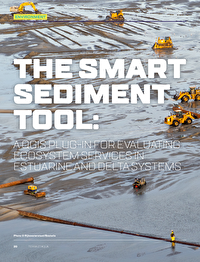Apitz, S. E. 2012.
Conceptualizing the Role of Sediment in Sustaining Ecosystem Services: Sediment-Ecosystem Regional Assessment. Science of the Total Environment 415:9-30.
Barbier, E.B., Hacker, S.D., Kennedy, C.J., Koch, E.W., Stier, A.C. & Silliman, B.R. 2011.
The Value of Estuarine and Coastal Ecosystem Services. Ecological Monographs 81:169-93.
Boerema, A. & Meire, P. 2017.
Management for Estuarine Ecosystem Services: A Review. Ecological Engineering 98:172-82.
Boerema, A., Geerts, L., Oosterlee, L., Temmerman, S. & Meire, P. 2016a.
Ecosystem Service Delivery in Restoration Projects: the Effect of Ecological Succession on the Benefits of Tidal Marsh Restoration. Ecology and Society 21:10.
Boerema, A., Rebelo, A.J., Bodi, M.B., Esler, K.J. & Meire, P. 2017.
Are Ecosystem Services Adequately Quantified? Journal of Applied Ecology 54:358-70.
Boerema, A., Van der Biest, K. & Meire, P. 2016b.
‘Ecosystem Services: Towards Integrated Maritime Infrastructure Project Assessments.’ ECOBE report 016-R190. Antwerp: University of Antwerp. Commissioned by IADC.
Bohnke-Henrichs, A., Baulcomb, C., Koss, R., Hussain, S.S. & De Groot, R.S. 2013.
Typology and Indicators of Ecosystem Services for Marine Spatial Planning and Management. Journal of Environmental Management 130:135-45.
Boudewijn, T.J. 2016.
‘Passende Beoordeling Zandsuppletie Roggenplaat: Toetsing in het kader van de Natuurbeschermingswet 1998 en Natuurnetwerk Nederland’. Nederland: Bureau Waardenburg Ecologie & landschap.
Brils, J., De Boer, P., Mulder, J. & De Boer, E. 2014.
Reuse of Dredged Material as a Way to Tackle Societal Challenges. Journal of Soils and Sediments 14:1638-41.
CEDA 2013.
‘Ecosystem Services and Dredging and Marine Construction’. Delft, the Netherlands: Central Dredging Association (CEDA). CICES 2020. ‘Common International Classification of Ecosystem Services (CICES) for Integrated Environmental and Economic Accounting, version V5.1 spreadsheet.’ https://cices.eu/content/uploads/sites/8/2018/03/Finalised-V5.1_18032018.xlsx
de Ronde, J., Mulder, J.P.M., van Duren, L.A., Ysebaert, T., 2013.
‘Eindadvies ANT Oosterschelde (Concluding Advice Autonomous Negative Trend Oosterschelde)’, Deltares Report 1207722-000- ZKS-0010. December 2013 (in Dutch).
De Swerdt, S., Boerema A., Van der Biest K., Vrebos D., Buis K., Taal M., Maris T., Mestdagh S., Ysebaert T., Van Holland G., Depreiter D., Meire P., 2020.
‘Smartsediment Ecosystem Services-tool Manual’. Version: 28 Aug. 2020. Interreg project Smartsediment. NIOZ. Haines-Young, R. & Potschin, M. 2013.
‘Common International Classification of Ecosystem Services (CICES): Consultation on Version 4, August-December 2012.’ EEA Framework Contract No EEA/IEA/09/003 (Download at www.cices.eu or www.nottingham.ac.uk/cem).
Jacobs, S., Wolfstein, K., Vandenbruwaene, W., Vrebos, D., Beauchard, O., Maris, T. & Meire, P. 2015.
Detecting Ecosystem Service Trade-offs and Synergies: A Practiceoriented Application in Four Industrialized Estuaries. Ecosystem Services 16:378-89.
Liquete, C., Piroddi, C., Drakou, E.G., Gurney, L., Katsanevakis, S., Charef, A. & Egoh, B. 2013.
Current Status and Future Prospects for the Assessment of Marine and Coastal Ecosystem Services: A Systematic Review. PLoS ONE, 8, e67737.
MEA 2005.
Ecosystems and Human Well-being: Current State and Trends. Millenium Ecosystem Assessmen. Washington: Island Press. Nienhuis P.H. & Smaal A.C., 1994.
The Oosterschelde Estuary, a Case-study of a Changing Ecosystem: An Introduction. Hydrobiologia 282/283:1-14.
PIANC 2016.
‘PIANC Orientation Paper: Opportunities to Apply the Concept of Ecosystem Services (ES) to the Waterborne Transport Infrastructure (WTI) Sector.’ PIANC-EnviCom Environment Commission.
TEEB 2010.
‘The Economics of Ecosystems and Biodiversity: The Ecological and Economic Foundations.’
Turner, K. & Schaafsma, M. 2015.
Coastal Zones Ecosystem Services: From Science to Values and Decision-Making. Studies in Ecological Economics. Switzerland: Springer.
UNEP 2009.
‘A Contribution to the United Nations World Water Assessment Programme (WWAP): The Critical Connection.’ Nairobi, Kenya: United Nations Environment Programme (UNEP).
UN-WATER 2014.
‘A Post-2015 Global Goal for Water: Synthesis of Key Findings and Recommendations from UN-Water.’ United Nations (UN) interagency mechanism for all freshwater and sanitation related matters (UN-Water).
Van der Meulen, E.S., Braat, L.C. & Brils, J.M. 2016.
Abiotic Flows Should be Inherent Part of Ecosystem Services Classification. Ecosystem Services 19:1-5.
Van der Werf, J., Boersema, M., Bouma, T., Schrijvershof, R., Stronkhorst, J., De Vet, L. & Ysebaert, T. 2016.
‘Definitief Ontwerp Roggenplaat Suppletie.’ Delft, Vlissingen, Yerseke: Centre of Expertise Delta Technology.
Verheyen, B., Van Holland G. & Boerema A., 2020.
‘Toepassingsmogelijkheden ESD-tool: Praktijkgeval Vogeleiland’. NO20069. Antwerp, IMDC.
Vrebos, D., Staes, J., Broekx, S., de Nocker, L., Gabriels, K., Hermy, M., Liekens, I., Marsboom, C., Ottoy, S., Van Der Biest, K., van Orshoven, J. & Meire, P. 2020.
Facilitating Spatially-Explicit Assessments of Ecosystem Service Delivery to Support Land Use Planning. One Ecosystem 5.
Ysebaert, T., Van der Werf, J., Boersema, M., Schrijvershof, R., Stronkhorst, J., De Vet, L., Debrot, A. & Bouma, T. 2016.
‘T-0 Rapportage Roggenplaat Suppletie.’ Centre of expertise Delta Technology.
Ysebaert, T., Van der Werf, J., De Vet, L. & Bouma, T. 2017.
‘Monitoringsplan Roggenplaat suppletie.’ Yerseke, Delft, Vlissingen:Centre of Expertise Delta Technology.





























